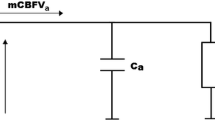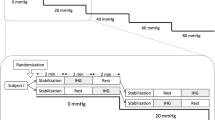Abstract
In the normocapnic range, middle cerebral artery mean velocity (MCA V mean) changes ∼ 3.5% per mmHg carbon-dioxide tension in arterial blood (PaCO2) and a decrease in PaCO2 will reduce the cerebral blood flow by vasoconstriction (the CO2 reactivity of the brain). When standing up MCA V mean and the end-tidal carbon-dioxide tension (PETCO2) decrease, suggesting that PaCO2 contributes to the reduction in MCA V mean. In a fixed body position, PETCO2 tracks changes in the PaCO2 but when assuming the upright position, cardiac output \((\dot {Q})\) decreases and its distribution over the lung changes, while ventilation \((\dot {V}_{{\rm E}})\) increases suggesting that PETCO2 decreases more than PaCO2. This study evaluated whether the postural reduction in PaCO2 accounts for the postural decline in MCA V mean. From the supine to the upright position, \(\dot {V}_{{\rm E}},\) \(\dot {Q},\) PETCO2, PaCO2, MCA V mean, and the near-infrared spectrophotometry determined cerebral tissue oxygenation (CO2Hb) were followed in seven subjects. When standing up, MCA V mean (from 65.3±3.8 to 54.6±3.3 cm s−1 ; mean ± SEM; P<0.05) and cO2Hb (−7.2±2.2 μmol l−1 ; P<0.05) decreased. At the same time, the \(\dot {V}_{{\rm E}}/\dot {Q}\) ratio increased 49±14% (P<0.05) with the postural reduction in PETCO2 overestimating the decline in PaCO2 (−4.8±0.9 mmHg vs. −3.0±1.1 mmHg; P<0.05). When assuming the upright position, the postural decrease in MCA V mean seems to be explained by the reduction in PETCO2 but the small decrease in PaCO2 makes it unlikely that the postural decrease in MCA V mean can be accounted for by the cerebral CO2 reactivity alone.


Similar content being viewed by others
References
Al-Rawi PG, Smielewski P, Kirkpatrick PJ (2001). Evaluation of a near-infrared spectrometer (NIRO 300) for the detection of intracranial oxygenation changes in the adult head. Stroke 32:2492–2500
Anthonisen NR, Bartlett D, Tenney SM (1965) Postural effect on ventilatory control. J Appl Physiol 20:191–196
Bishop CC, Powell S, Rutt D, Browse NL (1986) Transcranial Doppler measurement of middle cerebral artery blood flow velocity: a validation study. Stroke 17:913–915
Bjurstedt H, Hesser CM, Liljestrand G, Matell G (1962) Effects of posture on alveolar-arterial CO2 and O2 differences and alveolar dead space in man. Acta Physiol Scand 54:65–82
Blaber AP, Bondar RL, Moradshahi P, Serrador JM, Hughson RL (2001) Inspiratory CO2 increases orthostatic tolerance during repeated tilt. Aviat Space Environ Med 72:985–991
Bode H (1991) Cerebral blood flow velocities during orthostasis and physical exercise. Eur J Pediatr 150:738–743
Bogert LW, Van Lieshout JJ (2005) Non-invasive pulsatile arterial pressure and stroke volume changes from the human finger. Exp Physiol 90:437–446
Boushel R, Pott F, Madsen P, Radegran G, Nowak M, Quistorff B, Secher NH (1998) Muscle metabolism from near infrared spectroscopy during rhythmic handgrip in humans. Eur J Appl Physiol 79:41–48
Cencetti S, Bandinelli G, Lagi A (1997). Effect of PCO2 changes induced by head-upright tilt on transcranial Doppler recordings. Stroke 28:1195–1197
Charkoudian N, Joyner MJ, Johnson CP, Eisenach JH, Dietz NM, Wallin BG (2005) Balance between cardiac output and sympathetic nerve activity in resting humans: role in arterial pressure regulation. J Physiol 568:315–321
Clark JM, Skolnick BE, Gelfand R, Farber RE, Stierheim M, Stevens WC, Beck GJ, Lambertsen CJ (1996) Relationship of 133Xe cerebral blood flow to middle cerebral arterial flow velocity in men at rest. J Cereb Blood Flow Metab 16:1255–1262
Esaki K, Hamaoka T, Radegran G, Boushel R, Hansen J, Katsumura T, Haga S, Mizuno M (2005) Association between regional quadriceps oxygenation and blood oxygen saturation during normoxic one-legged dynamic knee extension. Eur J Appl Physiol 95:361–370
Floyd TF, Clark JM, Gelfand R, Detre JA, Ratcliffe S, Guvakov D, Lambertsen CJ, Eckenhoff RG (2003) Independent cerebral vasoconstrictive effects of hyperoxia and accompanying arterial hypocapnia at 1 ATA. J Appl Physiol 95:2453–2461
Gauer OH, Thron HL (1965) Postural changes in the circulation. In: Shepherd JT, Abboud FM (eds) Handbook of physiology. Sect. 2: the cardiovascular system. The peripheral circulation, vol 3. American Physiological Society, Washington DC, pp 2409–2439
Giller CA, Bowman G, Dyer H, Mootz L, Krippner W (1993) Cerebral arterial diameters during changes in blood pressure and carbon dioxide during craniotomy. Neurosurgery 32:737–741
Gisolf J, Wilders R, Immink RV, Van Lieshout JJ, Karemaker JM (2004) Tidal volume, cardiac output and functional residual capacity determine end-tidal CO2 transient during standing up in humans. J Physiol 554:579–590
Gruhn N, Larsen FS, Boesgaard S, Knudsen GM, Mortensen SA, Thomsen G, Aldershvile J (2001) Cerebral blood flow in patients with chronic heart failure before and after heart transplantation. Stroke 32:2530–2533
Harms MPM, Van Lieshout JJ (2001) Cerebrovascular and cardiovascular responses associated with orthostatic intolerance and tachycardia. Clin Auton Res 11:35–38
Harms MPM, Wesseling KH, Pott F, Jenstrup M, Van Goudoever J, Secher NH, Van Lieshout JJ (1999) Continuous stroke volume monitoring by modelling flow from non-invasive measurement of arterial pressure in humans under orthostatic stress. Clin Sci 97:291–301
Harms MPM, Colier WNJM, Wieling W, Lenders JW, Secher NH, Van Lieshout JJ (2000) Orthostatic tolerance, cerebral oxygenation, and blood velocity in humans with sympathetic failure. Stroke 31:1608–1614
Ide K, Boushel R, Sorensen HM, Fernandes A, Cai Y, Pott F, Secher NH (2000) Middle cerebral artery blood velocity during exercise with beta-1 adrenergic and unilateral stellate ganglion blockade in humans. Acta Physiol Scand 170:33–38
Ide K, Eliasziw M, Poulin MJ (2003) The relationship between middle cerebral artery blood velocity and end-tidal PCO2 in the hypocapnic-hypercapnic range in humans. J Appl Physiol 95:129–137
Immink RV, van den Born BJ, Van Montfrans GA, Koopmans RP, Karemaker JM, Van Lieshout JJ (2004) Impaired cerebral autoregulation in patients with malignant hypertension. Circulation 110:2241–2245
Kastrup A, Thomas C, Hartmann C, Schabet M (1997) Sex dependency of cerebrovascular CO2 reactivity in normal subjects. Stroke 28:2353–2356
Lambertsen CJ (1978) Effects of hyperoxia on organs and their tissues. In: Robin E (ed) Extrapulmonary manifestations of respiratory disease. M. Dekker, New York, pp 239–303
LeMarbre G, Stauber S, Khayat RN, Puleo DS, Skatrud JB, Morgan BJ (2003) Baroreflex-induced sympathetic activation does not alter cerebrovascular CO2 responsiveness in humans. J Physiol 551(2):609–616
Lennox WG, Gibbs EL (1932) Blood flow in brain and leg of man, and changes induced by alteration of blood gases. J Clin Invest 11:1155–1177
Madsen PL, Secher NH (1999) Near-infrared oximetry of the brain. Prog Neurobiol 58:541–560
Madsen P, Lyck F, Pedersen M, Olesen HL, Nielsen H, Secher NH (1995) Brain and muscle oxygen saturation during head-up-tilt-induced central hypovolaemia in humans. Clin Physiol 15:523–533
Madsen P, Pott F, Olsen SB, Nielsen HB, Burcev I, Secher NH (1998) Near-infrared spectrophotometry determined brain oxygenation during fainting. Acta Physiol Scand 162:501–507
Ogoh S, Volianitis S, Nissen P, Wray DW, Secher NH, Raven PB (2003) Carotid baroreflex responsiveness to head-up tilt-induced central hypovolaemia: effect of aerobic fitness. J Physiol 551:601–608
Ogoh S, Brothers RM, Barnes Q, Eubank WL, Hawkins MN, Purkayastha S, Yurvati A, Raven PB (2005) The effect of changes in cardiac output on middle cerebral artery mean blood velocity at rest and during exercise. J Physiol 569:697–704
Panerai RB, Deverson ST, Mahony P, Hayes P, Evans DH (1999) Effects of CO2 on dynamic cerebral autoregulation measurement. Physiol Meas 20:265–275
Pott F, Van Lieshout JJ, Ide K, Madsen P, Secher NH (2003) Middle cerebral artery blood velocity during intense static exercise is dominated by a Valsalva maneuver. J Appl Physiol 94:1335–1344
Reivich M (1964) Arterial PCO2 and cerebral hemodynamics. Am J Physiol 206:25–35
Riley RL, Cournand A (1951) Analysis of factors affecting partial pressures of oxygen and carbon dioxide in gas and blood of lungs: theory. J Appl Physiol 4:77–101
Riley RL, Permutt S, Said S, Godfey M, Cheng TO, Howell JBL, Shepard RH (1959) Effect of posture on pulmonary dead space in man. J Appl Physiol 14:339–344
Roy CS, Sherrington CS (1890) On the regulation of the blood supply to the brain. J Physiol 11:85–108
Scheinberg P, Stead EA (1949) The cerebral blood flow in male subjects as measured by the nitrous oxide technique. Normal values for blood flow, oxygen utilization, glucose utilization and peripheral resistance, with observations on the effect of tilting and anxiety. J Clin Invest 28:1163–1171
Serrador JM, Picot PA, Rutt BK, Shoemaker JK, Bondar RL (2000) MRI measures of middle cerebral artery diameter in conscious humans during simulated orthostasis. Stroke 31:1672–1678
Serrador JM, Hughson RL, Kowalchuk JM, Bondar RL, Gelb AW (2005) Cerebral blood flow during Orthostasis: The role of arterial CO2. Am J Physiol Regul Integr Comp Physiol; doi:10.1152/ajpregu.00446.2005
Umeyama T, Kugimiya T, Ogawa T, Kandori Y, Ishizuka A, Hanaoka K (1995) Changes in cerebral blood flow estimated after stellate ganglion block by single photon emission computed tomography. J Auton Nerv Syst 50:339–346
Van Beekvelt MC, Colier WNJM, Wevers RA, Van Engelen BG (2001) Performance of near-infrared spectroscopy in measuring local O2 consumption and blood flow in skeletal muscle. J Appl Physiol 90:511–519
Van Lieshout JJ, Pott F, Madsen PL, Van Goudoever J, Secher NH (2001) Muscle tensing during standing: effects on cerebral tissue oxygenation and cerebral artery blood velocity. Stroke 32:1546–1551
Van Lieshout JJ, Toska K, Van Lieshout EJ, Eriksen M, Walloe L, Wesseling KH (2003b) Beat-to-beat noninvasive stroke volume from arterial pressure and Doppler ultrasound. Eur J Appl Physiol 90:131–137
Van Lieshout JJ, Wieling W, Karemaker JM, Secher NH (2003a) Syncope, cerebral perfusion, and oxygenation. J Appl Physiol 94:833–848
Visocchi M, Chiappini F, Cioni B, Meglio M (1996) Cerebral blood flow velocities and trigeminal ganglion stimulation. A transcranial Doppler study. Stereotact Funct Neurosurg 66:184–192
Young WL, Prohovnik I, Ornstein E, Ostapkovich N, Matteo RS (1991) Cerebral blood flow reactivity to changes in carbon dioxide calculated using end-tidal versus arterial tensions. J Cereb Blood Flow Metab 11:1031–1035
Zhang R, Zuckerman JH, Levine BD (1998) Deterioration of cerebral autoregulation during orthostatic stress: insights from the frequency domain. J Appl Physiol 85:1113–1122
Zhang R, Zuckerman JH, Iwasaki K, Wilson TE, Crandall CG, Levine BD (2002) Autonomic neural control of dynamic cerebral autoregulation in humans. Circulation 106:1814–1820
Zhang R, Crandall CG, Levine BD (2004) Cerebral hemodynamics during the Valsalva maneuver. Insights from ganglionic blockade. Stroke 35:843–847
Author information
Authors and Affiliations
Corresponding author
Rights and permissions
About this article
Cite this article
Immink, R.V., Secher, N.H., Roos, C.M. et al. The postural reduction in middle cerebral artery blood velocity is not explained by PaCO2 . Eur J Appl Physiol 96, 609–614 (2006). https://doi.org/10.1007/s00421-006-0136-6
Accepted:
Published:
Issue Date:
DOI: https://doi.org/10.1007/s00421-006-0136-6




